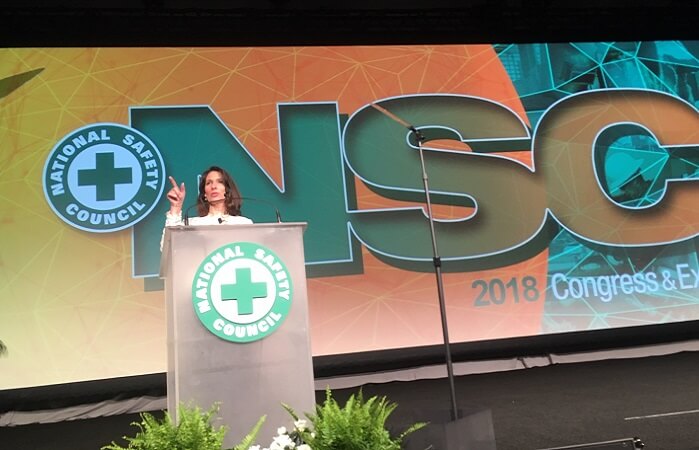Learning to See Hazards Clearly
From Debbie Hersman's Opening Session speech at the 2018 NSC Congress and Expo.
From Debbie Hersman's Opening Session speech at the 2018 NSC Congress and Expo.

Safety professionals aren’t born, they are trained. And it takes training to see hazards clearly. Before I got my glasses, my definition of normal consisted of blurry road signs at night and fuzzy patches of green where individual leaves might be. But the small act of putting on my glasses for the first time helped me see things as I should have seen them before.
The same goes for safety. If we continue to do things the wrong or unsafe way without consequence, we stop seeing the hazards.
Preventable injuries are now the third leading cause of death. For the first time in recorded history, more people in the prime of their lives are dying from preventable causes than ever before. We are becoming blind to everyday hazards. We are becoming complacent. We are rolling back protections for workers, increasing speed limits, and turning a blind eye to common risks like falls.
The problem is, we’re often not seeing the whole picture. The Center for Visual Expertise, or COVE, has created an innovative training program to help workers see hazards clearly.
The amazing thing about visual literacy is that once you learn to see the hazard, it’s much harder to “un-see” it. Now, it may be a little harder to spot the hazards in the modern workplace. They’re not as obvious. Factors like distraction and fatigue have an extraordinary impact, yet they aren’t always visible to the naked eye.
As we become more sophisticated, the hazard cues become more subtle. We have to develop a deeper understanding of what causes or contributes to risk.
Beyond just spotting the hazard, visual literacy leads us to ask three key questions:
Let’s look at road safety, for example. Motor vehicle crashes are the No. 1 cause of workplace fatalities. Those of us that drive every day become blind to the risks, but traffic safety professionals can see them clearly.
Safety professionals and engineers use the hierarchy of control system to do everything possible to eliminate or design out hazards. In a typical four-way intersection, there are 32 ways a crash can happen, but a roundabout cuts that down to just eight. While many people think roundabouts are frustrating, they are actually much safer.
Until 2013, motor vehicle crashes were the leading cause of preventable death. But the opioid epidemic is now the most significant public health crisis of our time. The signs were hidden in plain sight for well over a decade before we started paying attention.
We can’t ignore it any longer.
One of every four Americans has been directly affected by opioids. The problem is, people don’t see something familiar, like a bottle of pills, as potentially deadly.
We know a prescription after an injury is often how people get hooked, setting off a chain reaction of addiction that has devastated many families and communities.
Last year, we built a traveling memorial to the victims of the opioid crisis. Prescribed to Death portrays the faces of thousands of people lost to prescription opioids in just one year, but as the numbers continue to grow, the numbers themselves don’t tell the whole story. The memorial brings us face-to-face with an everyday killer. The personal stories shared in the memorial have opened the eyes of millions across the country. The memorial also provides solutions to help us eliminate preventable deaths.
Remember our three guiding questions: What do you see? What does it mean? And what are you going to do about it?
You can do something about this TODAY. These labels make it clear to you and your health care provider that you want to have a conversation about alternative, safer options.
Please, please talk to your loved ones, and share the Warn Me labels with them.
Once your focus is clear, you can help make these hazards visible to others. Remember, once we truly see something, we cannot un-see it. We all have a responsibility to keep each other safe, at work, at home and on the road.
With a century-long legacy, the National Safety Council is a global center for safety expertise. Let's work together to align resources. We look forward to learning about ways we can join efforts to expand safety everywhere!
There are no items in your cart